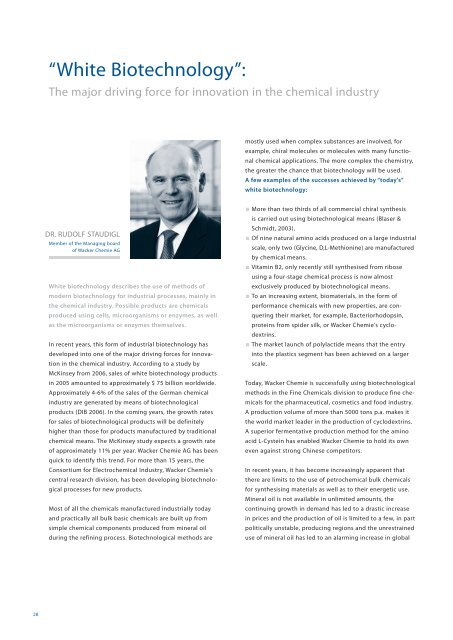251 286 - Biotech Bayern
251 286 - Biotech Bayern
251 286 - Biotech Bayern
Create successful ePaper yourself
Turn your PDF publications into a flip-book with our unique Google optimized e-Paper software.
28<br />
“White <strong>Biotech</strong>nology”:<br />
The major driving force for innovation in the chemical industry<br />
DR. RUDOLF STAUDIGL<br />
Member of the Managing board<br />
of Wacker Chemie AG<br />
White biotechnology describes the use of methods of<br />
modern biotechnology for industrial processes, mainly in<br />
the chemical industry. Possible products are chemicals<br />
produced using cells, microorganisms or enzymes, as well<br />
as the microorganisms or enzymes themselves.<br />
In recent years, this form of industrial biotechnology has<br />
developed into one of the major driving forces for innovation<br />
in the chemical industry. According to a study by<br />
McKinsey from 2006, sales of white biotechnology products<br />
in 2005 amounted to approximately $ 75 billion worldwide.<br />
Approximately 4-6% of the sales of the German chemical<br />
industry are generated by means of biotechnological<br />
products (DIB 2006). In the coming years, the growth rates<br />
for sales of biotechnological products will be definitely<br />
higher than those for products manufactured by traditional<br />
chemical means. The McKinsey study expects a growth rate<br />
of approximately 11% per year. Wacker Chemie AG has been<br />
quick to identify this trend. For more than 15 years, the<br />
Consortium for Electrochemical Industry, Wacker Chemie's<br />
central research division, has been developing biotechnological<br />
processes for new products.<br />
Most of all the chemicals manufactured industrially today<br />
and practically all bulk basic chemicals are built up from<br />
simple chemical components produced from mineral oil<br />
during the refining process. <strong>Biotech</strong>nological methods are<br />
mostly used when complex substances are involved, for<br />
example, chiral molecules or molecules with many functional<br />
chemical applications. The more complex the chemistry,<br />
the greater the chance that biotechnology will be used.<br />
A few examples of the successes achieved by “today's”<br />
white biotechnology:<br />
More than two thirds of all commercial chiral synthesis<br />
is carried out using biotechnological means (Blaser &<br />
Schmidt, 2003).<br />
Of nine natural amino acids produced on a large industrial<br />
scale, only two (Glycine, D,L-Methionine) are manufactured<br />
by chemical means.<br />
Vitamin B2, only recently still synthesised from ribose<br />
using a four-stage chemical process is now almost<br />
exclusively produced by biotechnological means.<br />
To an increasing extent, biomaterials, in the form of<br />
performance chemicals with new properties, are conquering<br />
their market, for example, Bacteriorhodopsin,<br />
proteins from spider silk, or Wacker Chemie's cyclodextrins.<br />
The market launch of polylactide means that the entry<br />
into the plastics segment has been achieved on a larger<br />
scale.<br />
Today, Wacker Chemie is successfully using biotechnological<br />
methods in the Fine Chemicals division to produce fine chemicals<br />
for the pharmaceutical, cosmetics and food industry.<br />
A production volume of more than 5000 tons p.a. makes it<br />
the world market leader in the production of cyclodextrins.<br />
A superior fermentative production method for the amino<br />
acid L-Cystein has enabled Wacker Chemie to hold its own<br />
even against strong Chinese competitors.<br />
In recent years, it has become increasingly apparent that<br />
there are limits to the use of petrochemical bulk chemicals<br />
for synthesising materials as well as to their energetic use.<br />
Mineral oil is not available in unlimited amounts, the<br />
continuing growth in demand has led to a drastic increase<br />
in prices and the production of oil is limited to a few, in part<br />
politically unstable, producing regions and the unrestrained<br />
use of mineral oil has led to an alarming increase in global


